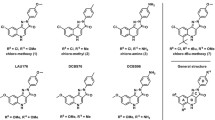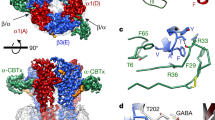Abstract
NEUROTRANSMISSION effected by GABA (γ-aminobutyric acid) is predominantly mediated by a gated chloride channel intrinsic to the GABAA receptor. This heterooligomeric receptor1 exists in most inhibitory synapses in the vertebrate central nervous system (CNS) and can be regulated by clinically important compounds such as benzodiazepines and barbiturates2. The primary structures of GABAA receptor α- and β-subunits have been deduced from cloned complementary DNAs3,4. Co-expression of these subunits in heterologous systems generates receptors which display much of the pharmacology of their neural counterparts, including potentiation by barbiturates3–5. Conspicuously, however, they lack binding sites for, and consistent electrophysiological responses to, benzodiazepines4,5. We now report the isolation of a cloned cDNA encoding a new GABAA receptor subunit, termed γ2, which shares approximately 40% sequence identity with α-and β-subunits and whose messenger RNA is prominently localized in neuronal subpopulations throughout the CNS. Importantly, coexpression of the γ2 subunit with α1 and β1 subunits produces GABAA receptors displaying high-affinity binding for central benzodiazepine receptor ligands.
Similar content being viewed by others
References
Stephenson, F. A. Biochem. J. 249, 21–32 (1988).
Benzodiazepine/GABA Receptors and Chloride Channels: Structural and Functional Properties (eds Olsen, R. W. & Venter, C. J.) (Liss, New York, 1986).
Schofield, P. R. et al. Nature 328, 221–227 (1987).
Levitan, E. S. et al. Nature 335, 76–79 (1988).
Pritchett et al. Science 242, 1306–1308 (1988).
Grenningloh, G. et al. Nature 328, 215–220 (1987).
Imoto, K. et al. Nature 335, 645–648 (1988).
Hopfield, J. F., Tank, D. W., Greengard, P. & Huganir, R. L. Nature 336, 677–680 (1988).
Noda, M. et al. Nature 302, 528–532 (1983).
Hunkeler, W. et al. Nature 290, 514–516 (1981).
Schofield, P. R. et al. FEBS Lett. (in the press).
Sieghart, W. & Schuster, A. Biochem. Pharmac. 33, 4033–4038 (1984).
Hamill, O. P., Marty, A., Neher, E., Sakmann, B. & Sigworth, F. I. Pflügers Arch. Ges. Physiol. 391, 85–100 (1981).
Skeritt, J. H. & MacDonald, R. L. Eur. J. Pharmac. 101, 135–141 (1984).
Young, W. S., III & Kuhar, M. J. Pharmac. Ther. 212, 337–346 (1980).
Richards, J. G. & Möhler, H. Neuropharmacology 23, 233–242 (1984).
Siegel, R. E. Neuron 1, 579–584 (1988).
Séquier, J. M. et al. Proc. natn. Acad. Sci. U.S.A. 85, 7815–7819 (1988).
Braestrup, C. & Nielsen, M. J. J. Neurochem. 37, 333–341 (1981).
Cooper, S. J., Karkham, T. C. & Estall, L. B. Trends pharmac. Sci. 8, 180–184 (1987).
Möhler, H. & Okada, T. Science 198, 849–851 (1977).
Casalotti, S. O., Stephenson, F. A. & Barnard, E. A. J. biol. Chem. 261, 15013–15016 (1986).
Fuchs, K., Möhler, H. & Sieghart, W. Neurosc. Lett. 90, 314–319 (1988).
von Heijne, G. Nucleic Acids Res. 14, 4683–4690 (1986).
Sanger, F., Nicklen, S. & Coulson, A. R., Proc. natn. Acad. Sci. U.S.A. 74, 5463–5467 (1977).
Vieira, J. & Messing, J. Meth. Enzym. 153, 3–11 (1987).
Eaton, D. L. et al. Biochemistry 25, 8343–8347 (1986).
Chen, C. & Okayama, H. Mol. cell. Biol. 7, 2745–2751 (1987).
Melton, D. A. et al. Nucleic Acids Res. 12, 7035–7056 (1984).
Shivers, B. D., Schachter, B. S. & Pfaff, D. W. Meth. Enzym. 124, 497–510 (1986).
Paxinos, G. & Watson, C. The Rat Brain in Stereotoxic Coordinates (Academic, Sidney, 1982).
Author information
Authors and Affiliations
Rights and permissions
About this article
Cite this article
Pritchett, D., Sontheimer, H., Shivers, B. et al. Importance of a novel GABAA receptor subunit for benzodiazepine pharmacology. Nature 338, 582–585 (1989). https://doi.org/10.1038/338582a0
Received:
Accepted:
Issue Date:
DOI: https://doi.org/10.1038/338582a0
- Springer Nature Limited
This article is cited by
-
Mild chronic perturbation of inhibition severely alters hippocampal function
Scientific Reports (2019)
-
Enhanced GABAergic actions resulting from the coapplication of the steroid 3α-hydroxy-5α-pregnane-11,20-dione (alfaxalone) with propofol or diazepam
Scientific Reports (2018)
-
Clinically applicable GABA receptor positive allosteric modulators promote ß-cell replication
Scientific Reports (2017)
-
Curcumol allosterically modulates GABA(A) receptors in a manner distinct from benzodiazepines
Scientific Reports (2017)
-
Orthosteric- versus allosteric-dependent activation of the GABAA receptor requires numerically distinct subunit level rearrangements
Scientific Reports (2017)





